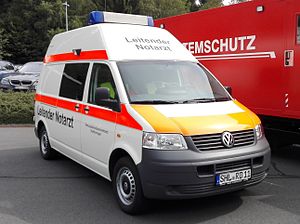Head emergency doctor


The chief emergency doctor (abbreviation "LNA" or "Ltd. emergency doctor") is a medical manager in major incidents and in the event of a disaster . He has to direct, coordinate and monitor all medical measures at the place of damage. In Germany he is part of the Sanitary Operations Management (SanEL) and in Austria part of the Emergency Operations Management . In some areas, however, the medical director of the rescue service is also referred to as the chief emergency doctor.
Leading emergency doctors are recruited from the group of active emergency doctors after they have been officially appointed by the main administrative officer .
tasks
The tasks of the chief emergency doctor include:
- Determination and assessment of the situation from a medical point of view (assessment of the situation, type of damage, type of injuries / illnesses, number of injured / sick people, intensity / extent of damage, additional hazards, damage development, relief from predicament, necessary deployment potential, number of workers required, especially doctors , Need for bandages, medication and medical equipment, necessary transport capacity, inpatient and outpatient treatment capacity)
- Determination of the focus and the type of medical use ( sighting , medical care, transport)
- Definition of treatment and transport priorities, medical care, delegation of medical tasks, definition of means of transport and transport destinations.
Indications for use
The alerting of the chief emergency doctor on duty takes place in accordance with the key word of the applicable alarm and release regulations (AAO). The various AAOs are therefore structured very differently, so that there are no uniform usage keywords. The classic indication for use is mass casualties .
Special features in Germany
education
In order to meet the high requirements of a chief emergency doctor, the German Medical Association has stated in its recommendation that a 40-hour seminar must be attended to qualify as a chief emergency doctor, which is based on the activity as an emergency doctor and at least five years as a doctor or a particularly relevant specialist certification builds up. The contents of the seminar include patient screening, legal principles and operational organization, technical topics and practical exercises. Regular activity in the rescue service is required. Knowledge of the regional rescue and health infrastructure is also important. Regular refresher seminars lasting at least eight hours should be attended.
function
Tasks, subordination, requirements / training, alerting / deployment indications, labeling and naming of the "leading emergency physicians" in Germany are regulated differently by the federal states, responsible district administrations or aid organizations. According to the German Medical Association, the tasks include assessing the situation, making decisions on how to solve the task, and formulating the necessary orders, including coordination with the overall operational management.
Normalization
The German Institute for Standardization (DIN) (Rescue Service and Hospital Standards Committee NARK and the Fire Brigade Standards Committee FNFW) defines the term in DIN 13050 "Rescue Services , Terms" (draft from April 2000):
- 3.17 Chief Emergency Doctor (LNA)
- A doctor working for the rescue service who has to direct all medical measures at the emergency location in the event of a large number of injured or sick people as well as other injured or affected persons or in the event of extraordinary events. The chief emergency doctor takes on medical management and coordination tasks. He has the appropriate qualifications and is appointed by the responsible public body.
The German Medical Association has essentially adopted this definition.
Special features in Austria
In the joint management of the medical service, the head of the rescue service and the chief emergency doctor are in principle on an equal footing, but due to their different responsibilities (comparable to those in Germany) they have to coordinate their respective concerns. Especially in rural regions of Austria it often happens that there is no head emergency doctor of his own, which is why this function is or has to be taken over by the regular emergency doctor in one area of responsibility. This "double burden" often leads to the fact that in practice the function of the chief emergency doctor only comes into action when there are several emergency medical supplies at one location, otherwise the only regular emergency doctor on duty takes over the initial inspection and first aid of patients at the location and leaves the management to the chief of operations of the rescue service, with whom he then agrees and advises him on medical matters.
literature
- Thomas Mitschke and Hanno Peter (eds.): Manual for quick deployment groups . 3rd edition, Stumpf and Kossendey-Verlag, Edewecht and Vienna 2000, ISBN 3-932750-30-6
- Peter Knuth, Peter Sefrin : Manual for the chief emergency doctor . ecomed Medicine, Heidelberg 1991, ISBN 3-609-71510-3
- Oliver Hoffmann: The legal status of the chief emergency doctor in the event of major damage incidents : seminar paper, University of Police, 2006
Individual evidence
- ↑ a b c d e for the German case: Emergency: Senior emergency doctor. Recommendations of the German Medical Association for advanced training to become a "Senior Emergency Doctor" (status 1988/2007)
- ↑ a b c Recommendations of the German Medical Association on the qualification of chief emergency physician (as of April 1, 2011)